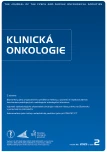Liver adenomatosis mimics metastatic liver involvement on FDG-PET/ CT
Authors:
O. Bělohlávek 1; M. Jarůšková 1; M. Šmakal 2
Authors‘ workplace:
Oddělení nukleární medicíny – PET centrum, Nemocnice Na Homolce, Praha
1; NH Hospital a. s., Onkologický stacionář, Hořovice
2
Published in:
Klin Onkol 2023; 36(2): 143-145
Category:
Case Report
doi:
https://doi.org/10.48095/ccko2023143
Overview
Background: Liver adenomatosis is a very rare disease. In the literature, we were able to find only two case reports documenting the appearance of this disease on PET/CT with 18F-fludeoxyglucose (FDG-PET/CT). Case: Numerous liver foci were detected during sonography in a 52-year-old female patient with uncharacteristic pain in the epigastrium without oncological history, with negative oncomarkers and without clinical signs of generalized neoplasia. Complementary MRI examination expressed the suspicion of metastatic origin of the foci, and FDG-PET/CT was indicated in order to identify the primary tumour and assess the extent of the disease. A whole-body FDG-PET/CT examination showed multiple (> 20) markedly hypermetabolic liver foci with 3–20 mm in diameter, reaching a relative accumulation of SUVBWmax = 13, together with several ametabolic cysts; elsewhere in the scope of the examination, focally pathologically increased metabolic activity was not evident. Subsequently, the patient underwent a biopsy targeted at one of the hypermetabolic liver foci with the finding of HNF 1A inactivated variant of hepatocellular adenoma; primary or secondary malignancy was not demonstrated. Considering the histological findings and the large number of liver foci, the final diagnosis of liver adenomatosis was set. The patient remains under continuous observation. Conclusion: Adenomatous foci were markedly hypermetabolic during FDG-PET/CT examination and could not be distinguished from tumour metastases by this method. Our finding is consistent with two other observations we were able to find in the literature.
Keywords:
liver – FDG-PET/CT – adenomatosis – hepatocellular adenoma
Sources
1. Ranstrom S. Miliary hepatocellular adenomatosis. Acta Pathol Microbiol Scand 1953; 33 (3): 225–229.
2. Flejou JF, Barge J, Menu Y et al. Liver adenomatosis: an entity distinct from liver adenoma? Gastroenterology 1985; 89 (5): 1132–1138.
3. Chiche L, Dao T, Salamé E et al. Liver adenomatosis: reappraisal, diagnosis, and surgical management eight new cases and review of the literature. Ann Surg 2000; 231 (1): 74–81. doi: 10.1097/00000658-200001000-00011.
4. Lammert C, Toal E, Mathur K et al. Large hepatic adenomas and hepatic adenomatosis: a multicenter study of risk factors, interventions, and complications. Am J Gastroenterol 2022; 117 (7): 1089–1096. doi: 10.14309/ajg.0000000000001743.
5. Ribeiro A, Burgart LJ, Nagorney DM et al. Management of liver adenomatosis: results with a conservative surgical approach. Liver Transpl Surg 1998; 4 (5): 388–398. doi: 10.1002/lt.500040505.
6. Lucas E, Pareja E, Carvajal N et al. Hepatic adenomatosis: a disease with controversial treatment. Cir Esp 2014; 92 (4): 284–286. doi: 10.1016/j.ciresp.2013.09. 006.
7. Lee SY, Kingham TP, LaGratta MD et al. PET-avid hepatocellular adenomas: incidental findings associated with HNF1-a mutated lesions. HPB (Oxford) 2016; 18 (1): 41–48. doi: 10.1016/j.hpb.2015.07.001.
8. Young JR, Graham RP, Venkatesh SK et al. 18F-FDG PET/CT of hepatocellular adenoma subtypes and review of literature. Abdom Radiol (NY) 2021; 46 (6): 2604–2609. doi: 10.1007/s00261-021-02968-2.
9. Sanli Y, Bakir B, Kuyumcu S et al. Hepatic adenomatosis may mimic metastatic lesions of liver with 18F-FDG PET/CT. Clin Nucl Med 2012; 37 (7): 697–698. doi: 10.1097/RLU.0b013e3182443ced.
10. Öz A, Koyuncu Sökmen B, İnan N et al. Incidentally detected PET-avid liver adenomatosis: MRI and 18F-FDG PET-CT findings. Turk J Gastroenterol 2018; 29 (5): 623–624. doi: 10.5152/tjg.2018.18105.
Labels
Paediatric clinical oncology Surgery Clinical oncologyArticle was published in
Clinical Oncology

2023 Issue 2
- Metamizole vs. Tramadol in Postoperative Analgesia
- Metamizole at a Glance and in Practice – Effective Non-Opioid Analgesic for All Ages
- Possibilities of Using Metamizole in the Treatment of Acute Primary Headaches
- Current Insights into the Antispasmodic and Analgesic Effects of Metamizole on the Gastrointestinal Tract
- Spasmolytic Effect of Metamizole
Most read in this issue
- Ixazomib – lenalidomide – dexamethason in heavily pretreated multiple myeloma patients – case reports
- Liver adenomatosis mimics metastatic liver involvement on FDG-PET/ CT
- Selected trends in head and neck cancer epidemiology in Slovakia – an international comparison
- Image guided adaptive brachytherapy of cervical cancer – practical recommendations
